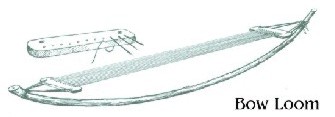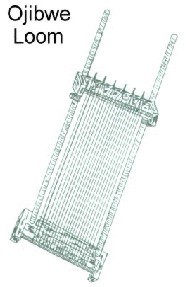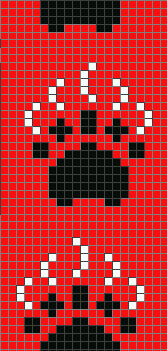|
|
Canku Ota |
|
|
(Many Paths) |
||
|
An Online Newsletter Celebrating Native America |
||
|
February 24, 2001 - Issue 30 |
||
|
|
||
|
The Beading Series |
||
|
by Lynne SageFlower Pennington |
||
|
|
|
Over the course of the next several issues, I will be instructing you how to do several beading stitches:
The Double Curve Motif is mostly done by the American Indians in the Northeast and the Huichol is done by people in Mexico. They are interesting to learn about and try. Each stitch will have step by step instructions and then a pattern for you to try on your own. At the end of each article I will place web sites and books on the stitch plus sites where you can find patterns. The first technique I am going to talk about is Loomwork. I am starting out with Loomwork because it is the first beading stitch I learned as a child and the easiest to start with.
Over the years, the loom has evolved from a single bowed branch used by our ancestors to more sophisticated looms made of metal which can cost up to $300.00. Below are pictures of a bow loom (loom used in the past) and a Ojibwe loom ( the one most used for loomwork today). Looms made today: Today, most loom work people use wooden looms, called in many bead supplier catalogs as Ojibwe looms or adjustable looms. Most looms lie flat but there are also some that are shaped in an L shape. To me it is a lot easier to work if I am doing wide loomwork to do my looming vertical then horizontal. Flat looms can be made to extend to several lengths and widths from 6 inches in length by 4 inches wide to 45 inches in length by 12 inches wide. The 45 inch one comes in handy when working on beaded strips for the sides of pants and the shoulders of shirts or jackets. The smaller one is great for making loomed pieces for pouches. If you are going to purchase a loom from a Craft suppler I suggest purchasing it from Crazy Crows Trading Post. He offers excellent wooden looms for a good price. I will place his web site link on the end of this article. There are many ways to make your own loom from wood from easy ones to more complex ones. They are really not hard to make and if you have a crafty parent then maybe if you ask them they will make one for you. I do have instructions on making different ones from using a strong box to wood ones, if you are interested email me at WtSageflower@ aol.com. My dad made some adjustments to my first Ojibwe loom before he started making them for me. They may be helpful to you also. He smoothed down the notched in the top on the end board and screwed in machine springs. This helped me with keeping my thread strands straight across from each other and from sliding out of the notches. Note to Parents: My best advise in not to buy the small metal ones from craft stores for your child. Not only will you find that they tend to loosen easy but the rollers often do not fit right in some cases. You end up buying more then one which to me is a waste of money. I purchased one for my daughter to try and she ended up getting frustrated because the loomwork was out of shape and loose. She ended up redoing all her work on a wooden loom. Terms used in Loomwork:
Materials you need for loomwork:
Instructions on bead looming: |
|
|


 There are many looms on the market. They are made from metals to wood. Their prices range from
hundreds of dollars (for metal ones) to less then $10.00 dollars.
There are many looms on the market. They are made from metals to wood. Their prices range from
hundreds of dollars (for metal ones) to less then $10.00 dollars.
.jpg)


